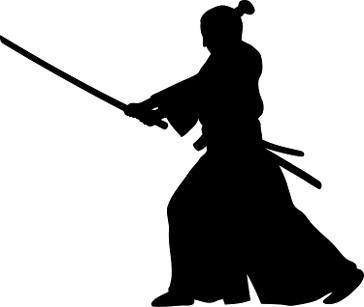
Classes for Jodo and Iaido are at Lansdowne Cres Primary School, Gourlay St , West Hobart.
Saturday afternoon 2.00 - 3.15 Jodo cost $5
3.30 - 5pm Iaido cost $5
National Membership $40 + $10 per Art
AKR Insurance $25
New students are welcome, some Martial Arts experience is essential
Iaido.
Iaido is the art of traditional Japanese Swordsmanship.
Practice begins with a Bokto ( wooden sword) progressing to an Iaito ( metal sword), and eventually to a Shinken a sharp ( live blade) sword.
You need to be at least 15 years of age and have previous Martial Arts experience to commence Iaido.
Etiquette
Iaido is a very structured art and the etiquette is of equal importance as the sword techniques.
Etiquette should be studied as an art in itself.
Each movement is developed for a reason, from holding the sword while walking through the Dojo to the folding of the Hakama at the end of the class each movement is considered and performed in a deliberate sequence.
History
The Tasmanian club evolved through an association between Soke Les Elliott and Master Ramon Lawrence, founder of the Budokan Academy, Perth W.A.
Master Lawrence has been a respected practitioner of Iaido for many years and was invited to assist in the formation of the Hobart group.
He continues to visit Hobart on a regular basis holding Seminars and Gradings.
It is through Master Lawrence that we are affiliated with Japan.
The Hobart Budokan club is directly affiliated with the Tasmanian Sando - Renmei, and in turn to the Australian Kendo Renmei the governing body in Australia for Seitei Iaido - Jodo.
Equipment.
You can start with basic equipment; Martial Arts uniform, Iaito Sword or wooden Bokto, Obi ( belt)
Your equipment wil be reviewed by the Instructor at various stages of your progress.
Dojo location and class times.
Lansdowne Cres Primary School, West Hobart, Tasmania.
Beginners and Intermediate students Saturday 2pm to 5pm
Advanced Invitation only class Wednesday 7.30 to 9pm.
Instructors profile.
Chief Instructor; Soke Les Elliott A.S.M.
A.M.A.H.O.F
Seitei Iaido Godan ( 5th Dan)
Seitei Jodo Yondan (4th Dan)
Tamiya Ryu Iaido - Shodan
Australian Iaido Kyu Grade Champion 2002 & 2003
Australian Jodo Kyu Grade Pairs Champion 2002
Australian Iaido Jodo Championships Hobart 2013, 2nd place - 4th Dan div.
Soke instructs an enthusiastic group in Hobart Tasmania. In 2004 Soke was invited to travel to Japan where he trained with Ueno Sensei and Ono Sensei who are considered 2 of the worlds most accomplished exponents of Tamiya Ryu Iaido and many other sword arts.
The culmination of this visit to japan was Elliott Soke's grading to Shodan by Soke Seirin Tsumaki.
Soke Tsumaki was the Head Master of the Tamiya Ryu School of Iaido. He passed away at the age of 103 in 2007.
Elliott Soke has a long association with many Martial Arts and is an inductee of the Australasian Martial Arts Hall of Fame as well as a recipient of the Australian Sports Medal for Services to Sport.
Jodo, " The way of the stick".
Founder Muso Gonosuke Katsuoshi developed the art of Jodo primarily as a defence against the sword.
Seitei Jodo is the basic form taught throughout the world.
In common with Iaido there are many schools of Jodo, all of which derive from the original style Shindo Muso Ryu.
The main advantage of the Jo over the Tachi ( sword ) is the added length and strength of the hardwood.
Jo dimensions - Length = 4 Shaku - 2 Sun - 1 Bu ( 50 1/4 inches) the Diameter = 8 Bu ( 1inch approx).
The type of wood used for the Jo is Kashi or Kashiwa ( Japanese Oak).
The All Japan Jodo Federation under the All Japan Kendo Federation and the direction of Shimizu Dai Sensei
introduced 12 Kihon and 12 selected Kata from Jojutsu.
Some Kata were simplified to make them easier to understand.
References are from "The way of the Stick" by Michael Finn. We reccomend this publication to all Jodo practitioners.